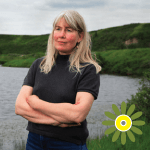
Encana/Ovintiv’s unlawful noisy belching compressors (13 around Rosebud alone, hundreds in the county) have invaded my body, mind, soul and home for decades and violate my legal right to quiet enjoyment of my home and land (I bought my place for its quiet and song birds).
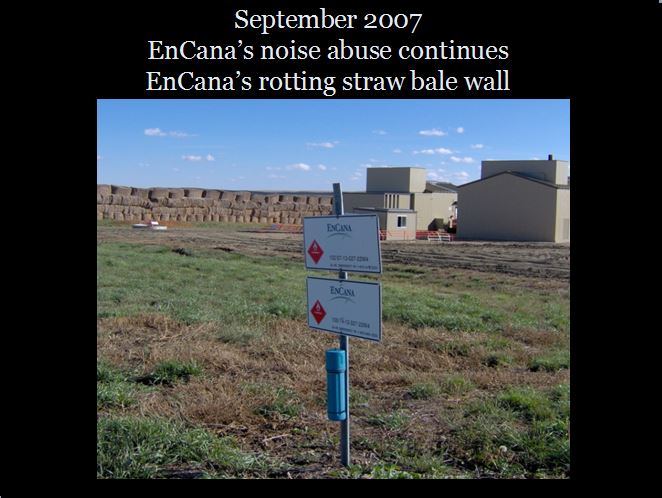
The compressor noise, now taken over by Lynx Energy, could easily have been prevented. Encana was required to conduct an appropriate noise assessment before installing the noisy ugly brutes, but that costs money which Encana hates to spend except for upper management.
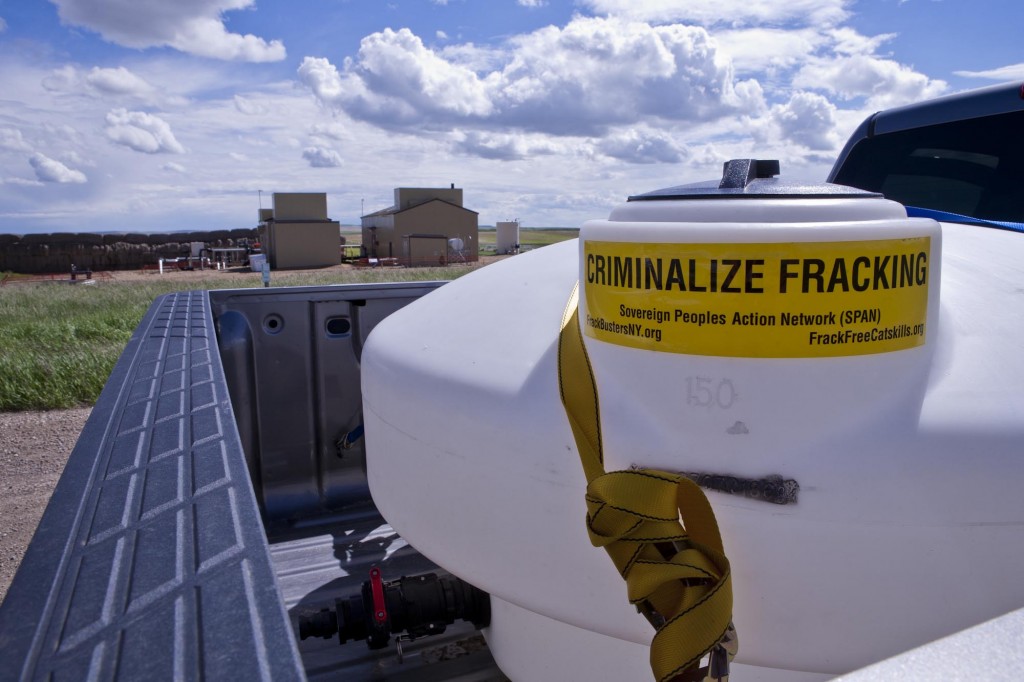
Encana/Ovintiv’s (now Lynx Energy’s) compressors near my home at Rosebud Alberta. Note the company’s moronic PR stunt of a flammable straw bale wall to the left of the left compressor. The straw wall did not mitigate the noise, it just rotted and wobbled over every few years and had to be replaced)
Frac’ers like Encana/Ovintiv rape us, wipe out other species, no matter how many, to bring in maximum profit for a few rich buggers. It’s “unnecessary noise” enabled by AER (Alberta’s infamous law-violating energy “regulator”).
I watched, heartbroken, year after year, as Encana’s illegal frac compressors drove out the many gold finches and other precious song birds that I shared my property with every spring and summer.
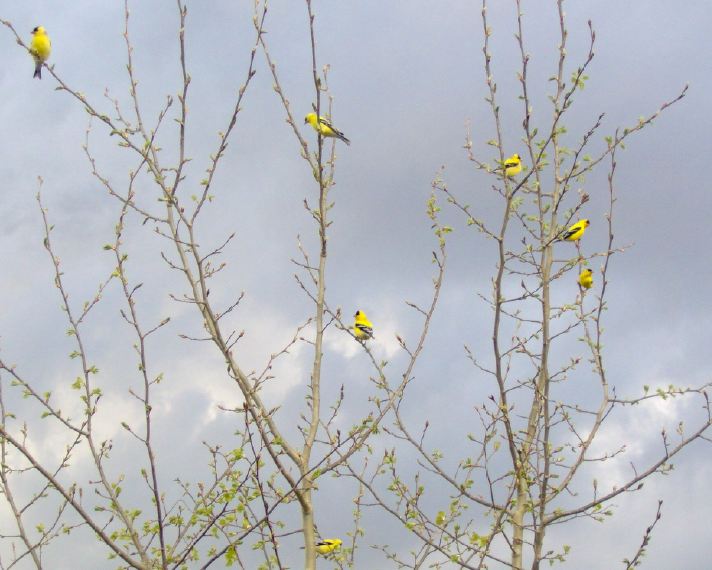
Gold finches, view from my kitchen window, pre-frac noise by Encana/Ovintiv/Lynx.
To add insult to the noise injuries, Encana completed two fraudulent noise studies, also enabled by AER. For the first study, Encana had their noisiest compressor turned off, and placed their microphone by the highway and community hall, a kilometre east of my house, to blame me for the noise (regulations stated the microphone must be 15 metres from complainant’s house). AER thought that was an excellent study, and I ought to shut up. I didn’t.
The second study, Encana’s fraud was worse, still the compressor noise violated AER’s noise control directive, so AER altered the company’s noise levels to make them compliant.
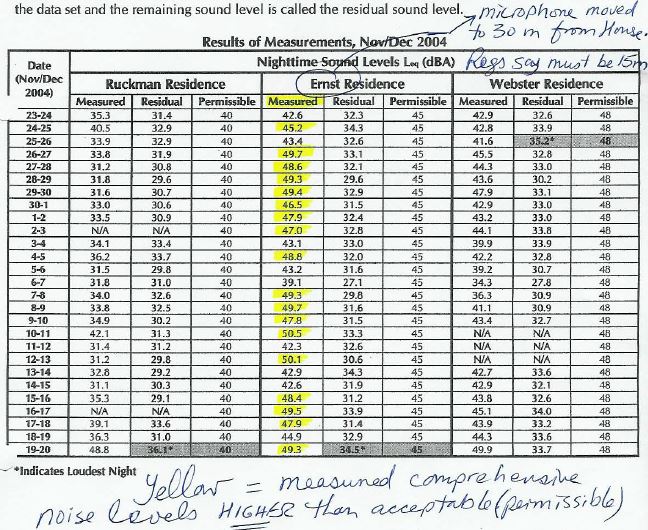
The data in Encana’s second noise study. EUB later became ERCB, is now AER.
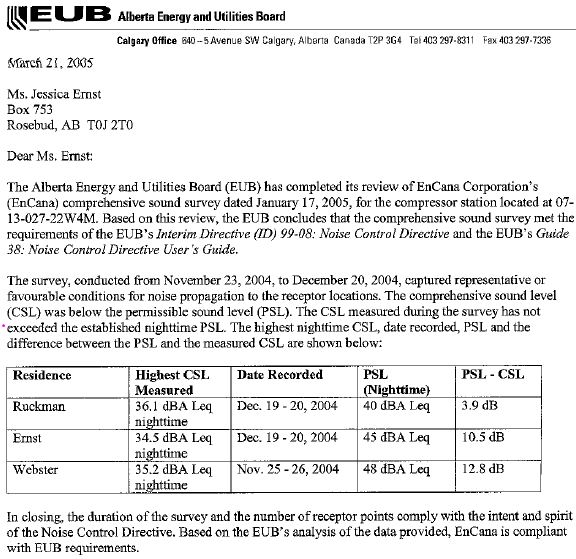
When that double fraud (by Encana and regulator) didn’t shut me up, the AER violated my charter rights in writing, judged me a criminal without any evidence, and no trial or hearing, copied the AG and RCMP, banishing me from energy regulation, to try to terrorize me quiet. The “regulator” refused and returned my registered mail when I wrote requesting what laws gave them the right to do this.
That noise is from just two compressors, there are many others surrounding the coulee where I live. I hate to think of the cumulative air pollution from Encana/Lynx’s compressors that we must breath.
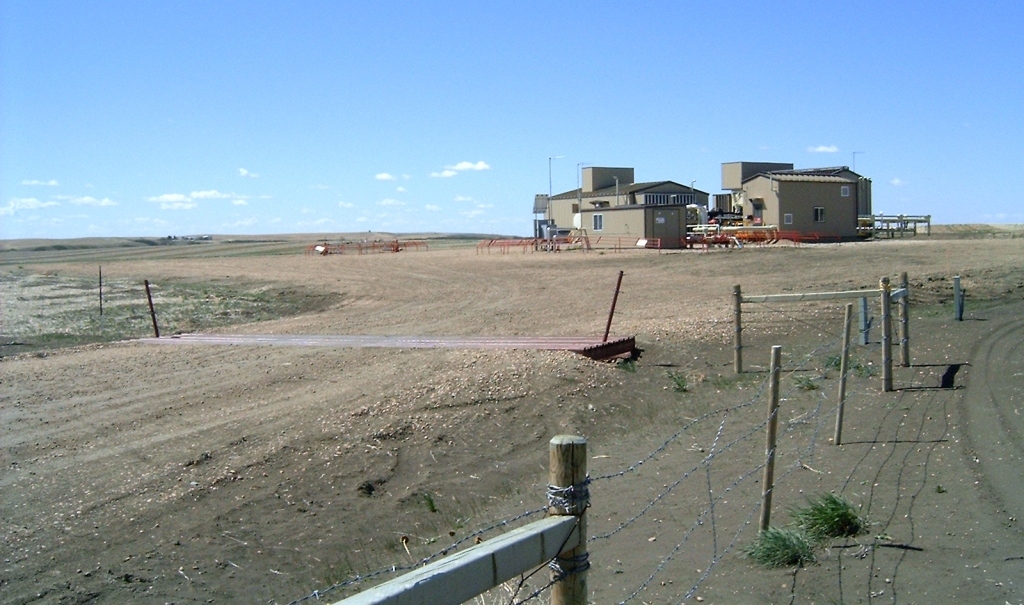
More Encana/Ovintiv now Lynx compressors around Rosebud.
Encana’s/Lynx’s noise not only violates my legal rights, it vibrates my sternum, churns my brain (one of my favourite things to do in life is be in quiet) and destroyed my home for me, and for many other species. It destroys my peace 24/7.
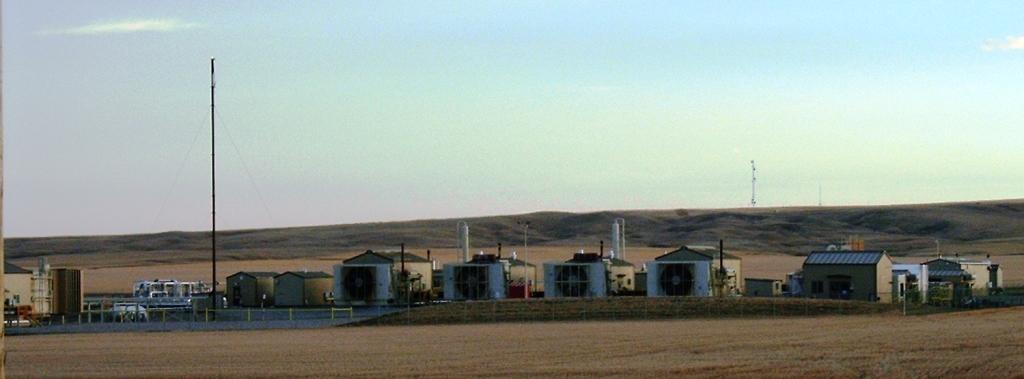
This summer, the noise has been much worse than in past years; winters, the noise is most invasive. Encana/Ovintiv dumped these onto Lynx, a small bit player. I expect Lynx will never clean them up, enabled by Alberta’s Godfather of the Patch, AER.![]()
Noise pollution is hurting animals – and we don’t even know how much by Fay Clark and Jacob Dunn, August 22, 2022, The Conversation
From construction projects to busy roads, aeroplanes and railways, human noise is everywhere. It is an invisible cause of stress, posing serious risks to human health and wellbeing. However, noise also harms animals living in close contact with humans, in homes, farms and zoos.
Noise is a distracting, scary or physically painful sound. The impacts of noise upon humans range from mild irritation to learning and memory problems, permanent hearing damage and heart disease.
Abnormally loud noise, such as at music concerts or construction sites, is controlled to protect human hearing. But noise is not regulated for other animals.
In our recent paper, we found a greater awareness and more understanding is needed into how noise harms pets, farm and working animals and zoo animals.
We can help you make informed decisions with our independent journalism.
Research tends to measure how loud a noise is in decibels (dB). Decibels are easy to measure with a handheld device and form the basis of human health guidelines. But the type of noise source, frequency (pitch), rate and duration can also impact how noise is experienced by a listener.
Great apes have similar hearing capabilities to humans, but the rest of the animal kingdom perceives noise very differently. Hearing ranges from very high frequency ultrasound (>20,000 Hz) echolocation in bats and dolphins to very low frequency infrasound (<20 Hz) in elephants. The hearing range of humans sits right between ultra and infrasound.
Some invertebrates such as hunting spiders detect sound from vibrations with their tiny leg hairs. It’s difficult to tell how sensitive an animal is to noise but what’s most important is whether noise in their environment is within their hearing range, rather than if the animal has a high or low frequency.
What we know
Due to a lack of research, we don’t know that much about how precisely noise affects animals but this is what we’ve learnt so far.
Loud noise can permanently damage lab rodents’ hearing. We can assume this exposure is painful because rats exposed to loud noise behave differently with and without pain medication. Findings in lab rodent studies can be generalised to other mammals but there are known differences in hearing ability across different animals.
Wild animals suffer chronic stress, fertility problems and change their migration routes in response to noise. Confined animals are often exposed to high levels of human-generated noise which they cannot escape.
Research shows noise causes confined animals pain, fear and cognitive problems. For example in fish, vibrations from extreme noise can damage the swim bladder which in turn impacts their hearing and buoyancy. Pain and fear are strong indicators of poor welfare.
Inaudible noise (vibrations) can also hurt animals by physically shaking their internal body parts. Farm animals experience high levels of vibration during transport. Our research group at Anglia Ruskin University is investigating whether vibrations from construction work impacts zoo primates.
One noisy event such as a local music festival or extreme weather can trigger long-term fear in animals. The link between noise and fear has been well studied in dogs using recordings of thunderstorms.
This kind of noise sensitivity, which affects up to 50% of pet dogs, is triggered by unexpected noises. It makes animals hide or seek human comfort. Farmed hens exposed to vehicle noise and even music also freeze in fear.
Primates, birds and frogs can adjust in the short term to noisy environments by vocalising louder, similar to raising our voices at noisy parties. But the long-term consequences of animals needing to change their methods of communication hasn’t been studied.
Long-term exposure to loud noise reduces learning and memory ability in lab mice. The link between cognition and anxiety in humans is complex but generally speaking, high levels of anxiety reduce our ability to perform challenging tasks.
This could be similar in other mammals but there is not enough research to be sure. Studying noise in zoos is difficult because it’s hard to control other factors, like weather and visitor presence.
How to help
If your pet is stressed by noise, a range of treatments are available to calm or distract them including synthetic pheromones and enrichment toys. But prevention is better than cure.
If you take care of confined animals, pay close attention to human activities that generate noise (such as cleaning and gardening) and how the surroundings may reflect sound waves. Sound waves can be blocked and bounce back from materials like concrete, metal and glass, which makes the noise worse.
You can protect your pets during noisy events, like thunderstorms and firework displays, by providing extra spaces to escape noise. Some soft furnishings like pillows or blankets inside a den help absorb sounds. A pile of blankets to crawl under, even without a den, will help to block out noise.
Better regulation is needed to protect animals from construction work and noisy events. Animals don’t have a say in what building projects or music concerts go ahead but they can suffer the consequences.
The war against noise goes back centuries, but Michael Enright argues it’s never been worse than now, From music in restaurants to digital information overload, noise in all forms is inescapable, Enright laments by Michael Enright, CBC Radio, Aug 21, 2022
Noise. It is annoying. It is everywhere. It is exhausting, stress-making and dangerous.
It keeps our nerves on a knife edge. We can run from it but we cannot hide.
According to the World Health Organization, noise pollution is second in harm to humans just behind air pollution. If you live in a big city in Canada there is no escape. Garbage trucks, leaf blowers, pneumatic drills, muscle cars, motorcycles, buses, subways and sirens. It is there when we wake up, it trails after us minute by minute until we go to sleep. Or try to. We are smothered by noise.
The WHO guideline for proper sleeping is less than 40 decibels of sound outside bedrooms. A 2017 study by Toronto Public Health revealed that 92 per cent of Toronto’s population is trying to sleep in a noise environment above 45 dB.
Globe and Mail columnist Marcus Gee has been fighting noise pollution, especially excessive street noise, for years. In his column in June he wrote about a friend who was awakened at 3:30 a.m. by motorcycles racing each other on a deserted parkway.
Much of the transportation noise is deliberate. Muscle cars and some high-end luxury cars can be fitted with special mufflers deliberately designed not to diminish engine noise but to substantially increase it.
For Gee, the noise demons are cars and motorbikes. For me, it’s restaurants.
Popular, busy restaurants are predictably noisy. But to add to normal noise levels, most restaurants pipe in loud and exceedingly terrible music.
Toronto media owner Moses Znaimer felt that restaurant noise had become such a modern scourge that he launched the Anti-Noise Pollution League in 2011, which included a user-generated list of quiet restaurants.
The league’s noble efforts don’t seem to have been noticeably effective.
When dining out, I used to carry two sets of business cards, some yellow and some blue. The blue cards are for quiet, no-music restaurants. The text congratulates the manager and announces that I will recommend the establishment to friends. The yellow cards inform the management of musical dining establishments that I will be telling friends to boycott their restaurant. In years of asking around, I have never encountered a customer who has asked for music to be played at a restaurant.
The war against noise has a long and storied tradition. In 1921, English engineer Henry John Spooner pushed for an “Anti-noise Day” or a “Day of Silence.” India liberator Mahatma Gandhi began a practice of passing every Monday in silence. He would attend necessary meetings, but would communicate by pad and pen. Florence Nightingale, in the midst of her nursing endeavours, referred to unnecessary noise as “the cruel absence of care.”
A new book sets out to clinically examine our increasingly noisy world and plots a way to find its opposite — silence. Golden: The Power of Silence in a World of Noise, by Justin Zorn and Leigh Marz, is both a warning and a prescription. But the authors agree that finding a welcoming silence is an uphill struggle.
They trace the quest for silence back more than 2,500 years to the days of Pythagoras, who urged his students: “Learn to be silent. Let your quiet mind listen and absorb.” To Pythagoras, silence was the key to wisdom.
All of humanity’s problems stem from man’s inability to sit quietly in a room alone.
– Blaise Pascal
But in the clamorous din of the 21st century, we are afraid of silence. We are fearful of simply being quiet. We need constant stimuli in order to prove something to ourselves; perhaps that we are alive and not alone.![]() Not me. I thrive in silence. I feel safe in silence. Since Encana invaded, I yearn for silence 24/7 and thanks to Alberta’s corrupt AER, I know I will never live with it again until I go deaf (if I live that long).
Not me. I thrive in silence. I feel safe in silence. Since Encana invaded, I yearn for silence 24/7 and thanks to Alberta’s corrupt AER, I know I will never live with it again until I go deaf (if I live that long).![]() The fear of silence is the fear of the unknown. Perhaps the 17th-century philosopher Blaise Pascal was right when he said, “All of humanity’s problems stem from man’s inability to sit quietly in a room alone.”
The fear of silence is the fear of the unknown. Perhaps the 17th-century philosopher Blaise Pascal was right when he said, “All of humanity’s problems stem from man’s inability to sit quietly in a room alone.”
Zorn and Marz explore the taxonomy of noise through three categories: auditory noise (e.g. cars and trucks), internal noise and informational noise — the constant flooding of our consciousness of mindless information. This is the noise of texts, emails and social media.
I’ve been chasing the Golden Fleece of silence for decades and I have mostly failed in the attempt. I have even tried the so-called “Digital Sabbath” when I turn off screens and phones from sundown Friday night to sundown Saturday.
My island of silence and sanity is travelling to the village of Weston in the Green Mountains of Vermont, and visiting the Benedictine monks of the Weston Priory. Before COVID-19, I would spend a week in the priory, usually in the fall, without a phone or a computer or any unnecessary contact with the outside world.
Meals are taken in silence. Dormitory rooms are dead quiet. I’ve never tried it for longer than a week. Someday I will. And I will keep looking for other islands of silence.
In a crazy and noisy world, I don’t think we have any other choice.
A few of the comments:
Maverick Blue:
Teck Cominco in Trail is louder than downtown Vancouver most days. As an audio producer and engineer the noise is totally unnecessary and due to poor design and construction. Solutions are available.
Brendr Phillips:
… We are all inundated by noise, all over the world now, becaues even in the remotest areas, airplane noise intrudes. I wonder why he didn’t mention planes, as small incredibly noisy Cessnas were for nearly two decades permitted to fly over a very quiet seaside community every summer despite constant complaints by residents. Birds that had been loud enough to wake a person up every dawn have now almost entirely disappeared. Tension is aggravated by noise, even when we don’t ‘mind’ it. And that ‘we’ is universal.
![]()
Refer also to:
New study: Songbirds’ reproductive success reduced by natural gas compressor noise.
University of Michigan researchers on noise: Turn down the volume for health’s sake
